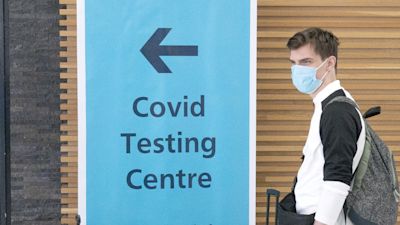Omicron: What are the new Covid testing and self-isolating rules?

From Tuesday, the rules on Covid testing and isolating have changed as cases of the Omicron variant continue to surge.
Omicron is expected to become the dominant strain in the UK by mid-December, but the government hope the new rules will reduce the risk of spreading the highly transmissible variant.
What are these new rules and how could they affect you?
What are the new rules on testing for Covid-19 contacts?
Double-jabbed people in England who are close contacts of Covid cases - whether Omicron or not - are now being asked to take a lateral flow test every day for seven days - or 10 days since their last contact with the person who tested positive for Covid-19 if this is earlier - to slow the spread of infections.
Unvaccinated adults "are not eligible for this new daily testing policy," and must self-isolate for 10 days if they are a contact of someone who tests positive for Covid, regardless of strain, unless eligible for an existing workplace daily contact testing.
How do I get lateral flow tests and are they available online?
Lateral flow tests are usually available to order online, but, amid a huge rise in demand following the updated guidance, for the second day running, lateral flow tests are unavailable to order on the government website, although tests can still be collected from pharmacies or collection points.
On Monday, the UK Health Security Agency said that “due to exceptionally high demand, ordering lateral flow tests on gov.uk has been temporarily suspended to fulfil existing orders”.
Are tests available in pharmacies?
Yes, but you'll need a 'collect code' before you can pick up lateral flow tests from the pharmacy.
You can do this either on the website or by calling 119 (free from landlines and mobiles) between 7am and 11pm.
Your collect code will be sent to you by email or text. You can collect test packs for your household or another household but you need to get a code for each household.
The government has insisted there are plenty of tests available, but there were reports on Tuesday of pharmacies being out of stock.
What should I do if my lateral flow test comes back positive?
If you are vaccinated and test positive or develop symptoms you must self-isolate straight away. Get a PCR test to confirm your result as soon as possible.
Even if your test comes back negative, you are being advised to limit close contact with other people outside your household, especially anyone who is more vulnerable, and to avoid crowded or enclosed spaces.
What are the rules around self-isolation if I test positive for Covid?
If your lateral flow comes back positive, continue to self-isolate until you get the result of the PCR test.
Even if your PCR is negative, you may still need to quarantine. In England, if you do the PCR test within two days of a positive rapid lateral flow test and your PCR test is negative, you can stop self-isolating. If you do the PCR test later than this, you'll need to self-isolate for 10 full days even if you get a negative PCR result.
The self-isolation period includes the day your symptoms started (or the day you had the test, if you do not have symptoms) and the next 10 full days
You will need to self-isolate if you have been informed by NHS Test and Trace that you are a contact of a person who has had a positive Covid result.
What do I do if I've come into contact with a person who has tested positive for the Omicron variant?
The same as above. From Tuesday, regardless of what Covid variant your contact has, you should test everyday and self-isolate if you get a positive lateral flow test.
How do I know if I have the Omicron variant?
The World Health Organization (WHO) has said PCR tests can detect Omicron infections.
The Omicron variant has multiple mutations to its spike protein, which is found on the virus’s surface. The spike protein plays a role in infecting cells and most PCR tests target several parts of the viral genome, including the S-gene that encodes the spike protein.
Listen to our coronavirus podcast:
Researchers in the UK have sequenced about 13.3% of all positive cases, compared with 3.8% in the US, according to GISAID, which promotes rapid sharing of data on Covid-19 and the flu.
But with Omicron likely to be the dominant strain in the UK in a matter of days, all Covid contacts are being treated the same, and you should test daily and self-isolate if you have symptoms or have a positive test.
The government website still lists the most important symptoms of Covid-19 as:
a new continuous cough
a high temperature
a loss of, or change in, your normal sense of taste or smell (anosmia)
But, the new Omicron variant of coronavirus appears to be causing “milder” cold-like symptoms.
According to the Zoe Covid Study incidence figures, there are currently 83,658 new daily symptomatic cases of Covid-19 in the UK on average, based on test data from up to five days ago.